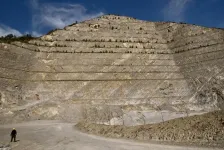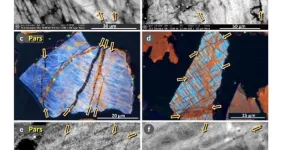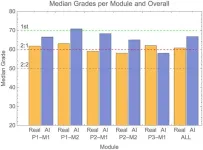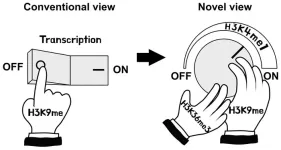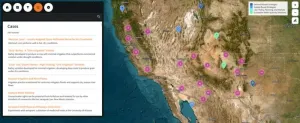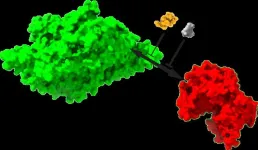(Press-News.org) DURHAM, NC – Researchers have discovered a clue in Italian limestone that helps explain a mass extinction of marine life millions of years ago, and may provide warnings about how oxygen depletion and climate change could impact today’s oceans.
“This event, and events like it, are the best analogs we have in Earth's past for what is to come in the next decades and centuries,” said Michael A. Kipp, an earth and climate science assistant professor at Duke University. Kipp co-authored a study published June 24 in the Proceedings of the National Academy of Sciences that measures oxygen loss in oceans leading to the extinction of marine species 183 million years ago.
During the Jurassic Period, when marine reptiles like ichthyosaurs and plesiosaurs thrived, volcanic activity in modern South Africa released an estimated 20,500 gigatons of carbon dioxide (CO2) over 500,000 years. This heated the oceans, causing them to lose oxygen.
The result was the suffocation and mass extinction of marine species.
“It’s an analog, but not a perfect one, to predict what will happen to future oxygen loss in oceans from human-made carbon emissions, and the impact that loss will have on marine ecosystems and biodiversity,” said co-author Mariano Remirez, an assistant research professor at George Mason University.
Studying limestone sediment that carries chemicals dating back to the time of the volcanic outburst, researchers were able to estimate the change in oxygen levels in ancient oceans. At one point, oxygen was completely depleted in up to 8% of the ancient global seafloor, an area roughly three times the size of the United States.
Since the Industrial Revolution began in the 18th and 19th centuries, human activity has released CO2 emissions equivalent to 12% of what was released during the Jurassic volcanism.
But Kipp said that today’s rapid rate of atmospheric CO2 release is unprecedented in history, making it hard to predict when another mass extinction might occur or how severe it might be.
“We just don't have anything this severe,” Kipp said. “We go to the most rapid CO2-emitting events we can in history, and they're still not rapid enough to be a perfect comparison to what we're going through today. We're perturbing the system faster than ever before.”
“We have at least quantified the marine oxygen loss during this event, which will help constrain our predictions of what will happen in the future,” Kipp said.
CITATION: “Carbonate Uranium Isotopes Record Global Expansion of Marine Anoxia During the Toarcian Oceanic Anoxic Event,” Mariano N. Remírez, Geoffrey J. Gilleaudeau, Tian Gan, Michael A. Kipp, François L. H. Tissot, Alan J. Kaufman, Mariano Parente. PNAS, June 24, 2024. DOI: 10.1073/pnas.2406032121
Online: www.pnas.org/doi/10.1073/pnas.2406032121
END
Ocean’s loss of oxygen caused massive Jurassic extinction. Could it happen again?
Italian limestone from the Mercato San Severino section in southern Italy tells the story of oceanic oxygen depletion
2024-06-26
ELSE PRESS RELEASES FROM THIS DATE:
Shocked quartz reveals evidence of historical cosmic airburst
2024-06-26
(Santa Barbara, Calif.) — Researchers continue to expand the case for the Younger Dryas Impact hypothesis. The idea proposes that a fragmented comet smashed into the Earth’s atmosphere 12,800 years ago, causing a widespread climatic shift that, among other things, led to the abrupt reversal of the Earth’s warming trend and into an anomalous near-glacial period called the Younger Dryas.
Now, UC Santa Barbara emeritus professor James Kennett and colleagues report the presence of proxies associated with the cosmic airburst ...
Chemotherapy disrupts gut microbiome in patients with breast cancer
2024-06-26
COLUMBUS, Ohio – Chemotherapy is known to cause behavioral side effects, including cognitive decline. Notably, the gut microbiome communicates with the brain to affect behavior, including cognition.
“For the first time ever, our Intelligut Study found that the gut microbiome has been implicated in cognitive side effects of chemotherapy in humans,” said senior author Leah Pyter, associate professor of psychiatry and neuroscience with The Ohio State University Wexner Medical Center and College of Medicine. ...
Microrobot-packed pill shows promise for treating inflammatory bowel disease in mice
2024-06-26
Engineers at the University of California San Diego have developed a pill that releases microscopic robots, or microrobots, into the colon to treat inflammatory bowel disease (IBD). The experimental treatment, given orally, has shown success in mice. It significantly reduced IBD symptoms and promoted the healing of damaged colon tissue without causing toxic side effects.
The study was published June 26 in Science Robotics.
IBD, an autoimmune disorder characterized by chronic inflammation of the gut, ...
Sharing false political information on social media may be associated with positive schizotypy
2024-06-26
Sharing false political information on social media by users may be associated with aspects of personality such as positive schizotypy, a set of traits including paranoia, suspicion and disrupted thinking patterns. It may also be linked to a motivation to increase awareness according to a study published June 26, 2024 in the open-access journal PLOS ONE by Tom Buchanan, University of Westminster, UK, and colleagues.
The spread of false political information on social media can tarnish trust in authentic news and even contribute to social unrest. Knowingly or not, a small portion of social media users actively share false material.
Buchanan and ...
AI-generated exam submissions evade detection at reputable UK university
2024-06-26
In a test of the examinations system of the University of Reading in the UK, artificial intelligence (AI)-generated submissions went almost entirely undetected, and these fake answers tended to receive higher grades than those achieved by real students. Peter Scarfe of the University of Reading and colleagues present these findings in the open-access journal PLOS ONE on June 26.
In recent years, AI tools such as ChatGPT have become more advanced and widespread, leading to concerns about students using them to cheat by submitting AI-generated work as their own. Such concerns are heightened ...
The on-and-off affair in DNA
2024-06-26
Researchers led by Kannosuke Yabe, Asuka Kamio, and Soichi Inagaki of the University of Tokyo have discovered that in thale cresses histone H3 lysine-9 (H3K9) methylation, conventionally thought to be a mark of turning off gene transcription, can also turn on gene expression via the interactions of two other proteins and histone marks. The molecular mechanisms demonstrate that rather than functioning as a simple “off switch,” H3K9 methylation is more like a “dimmer switch” that fine-tunes DNA transcription. The discovery suggests there might be similar mechanisms in other ...
New interactive atlas of water scarcity solutions in the US Southwest shares a library of case studies to help adapt to drought
2024-06-26
New interactive atlas of water scarcity solutions in the U.S. Southwest shares a library of case studies to help adapt to drought.
####
Article URL: https://journals.plos.org/water/article?id=10.1371/journal.pwat.0000246
Article Title: The water adaptation techniques atlas: A new geospatial library of solutions to water scarcity in the U.S. Southwest
Author Countries: United States
Funding: The authors have declared that no competing interests exist. END ...
AI generated exam answers go undetected in real-world blind test
2024-06-26
Experienced exam markers may struggle to spot answers generated by Artificial Intelligence (AI), researchers have found.
The study was conducted at the University of Reading, UK, where university leaders are working to identify potential risks and opportunities of AI for research, teaching, learning, and assessment, with updated advice already issued to staff and students as a result of their findings.
The researchers are calling for the global education sector to follow the example of Reading, and others who are also forming new ...
How do our memories last a lifetime? New study offers a biological explanation
2024-06-26
Whether it’s a first-time visit to a zoo or when we learned to ride a bicycle, we have memories from our childhoods kept well into adult years. But what explains how these memories last nearly an entire lifetime?
A new study in the journal Science Advances, conducted by a team of international researchers, has uncovered a biological explanation for long-term memories. It centers on the discovery of the role of a molecule, KIBRA, that serves as a “glue” to other molecules, thereby solidifying memory formation.
“Previous efforts to understand ...
Mechanical computer relies on kirigami cubes, not electronics
2024-06-26
North Carolina State University researchers have developed a kirigami-inspired mechanical computer that uses a complex structure of rigid, interconnected polymer cubes to store, retrieve and erase data without relying on electronic components. The system also includes a reversible feature that allows users to control when data editing is permitted and when data should be locked in place.
Mechanical computers are computers that operate using mechanical components rather than electronic ones. Historically, these mechanical components have been things like levers or gears. However, mechanical computers can also be made using structures that are multistable, meaning ...
LAST 30 PRESS RELEASES:
Clearing the brain of aging cells could aid epilepsy and reduce seizures
Brain injuries linked with potential risk of suicide, new study finds
New technique lights up where drugs go in the body, cell by cell
New study finds movement of fishing fleets can reveal shifts in marine ecosystems
Embargoed: New evidence points to potential treatment for vascular dementia
Study uncovers disrupted brain balance in alcohol dependence
Working in groups can help Republicans and Democrats agree on controversial content moderation online
Structural findings reveal how distinct GPCR ligands create different levels of activation
Anything-goes “anyons” may be at the root of surprising quantum experiments
UC review: Maximizing workplace opportunity for veterans
From generation to complex control: Metasurfaces make perfect vortex beams "within reach"
Thin-film lithium niobate-based detector: recent advances and perspectives
Exploring why some people may tend to persistently make bad choices
How cells balance their protein levels
Nirsevimab vs RSVpreF vaccine for RSV–related hospitalization in newborns
Effectiveness and impact of maternal RSV immunization and nirsevimab on medically attended RSV in US children
AI gives scientists a boost, but at the cost of too many mediocre papers
Next-generation vision model maps tree growth at sub-meter precision
Genes aren’t destiny for inherited blindness, study shows
MIT study: High-fat diets make liver cells more likely to become cancerous
Exposure to multiple fine particulate matter components and incident depression in the US Medicare population
Risk of burdensome health care spending over time in the US
Nirsevimab against hospitalizations and emergency department visits for lower respiratory tract infection in infants
New microfluidics technology enables highly uniform DNA condensate formation
A new strategy for immune tolerance
Super Mario Bros. help fight burnout: New study links classic games to boosted happiness
Deepest gas hydrate cold seep ever discovered in the arctic: International research team unveils Freya Hydrate Mounds at 3,640 m depth.
Integrating light and structure: Smarter mapping for fragile wetland ecosystems
ACA-SIM: A robust way to decode satellite signals over complex waters
Probiotics can restore gut microbiome in breastfed infants
[Press-News.org] Ocean’s loss of oxygen caused massive Jurassic extinction. Could it happen again?Italian limestone from the Mercato San Severino section in southern Italy tells the story of oceanic oxygen depletion
